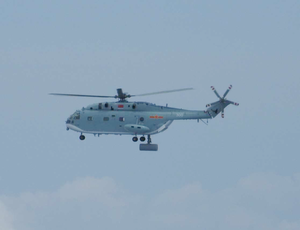Changhe Z-18
| Z-18 | |
|---|---|

| |
| PLANAF Changhe Z-18J AEW from the aircraft carrier Liaoning | |
| Role | Utility helicopter |
| National origin | China |
| Manufacturer | Avicopter (Changhe Aircraft Industries Corporation) |
| First flight | 2014[1] |
| Introduction | 2018 |
| Status | In service, in production |
| Primary user | People's Liberation Army |
| Developed from | Avicopter AC313 |
The Changhe Z-18, also known as Z-8G,[1] is a medium-lift transport helicopter developed by Changhe Aircraft Industries Corporation (CAIC) to replace the Changhe/Harbin Z-8.
Design and development
[edit]The Z-18 is a development of the Avicopter AC313 and Changhe/Harbin Z-8, both of which are developments of the Aérospatiale SA 321 Super Frelon.[2][1]
Notable changes include a redesigned lower fuselage similar to the AC313 which results in larger internal space.[3] It also reportedly makes greater use of titanium and composites in its rotor blades and rotor,[4] and replaces the Z-8's boat-shaped lower fuselage with a tail ramp for small vehicles.[1] It has a glass cockpit[2] and is powered by three WZ-6C turboshafts.[2][1]
The Z-18's maximum takeoff weight (MTOW) is 13.8 tonnes. In late-2014, the only People's Liberation Army Navy (PLAN) ships able to operate the helicopter at MTOW were aircraft carriers and large amphibious assault ships.[4]
Operational history
[edit]The Z-18F anti-submarine warfare (ASW) version was undergoing testing by the end of August 2014.[4]
The army transport Z-18A first appeared in Chinese state media in December 2014, and reportedly underwent high-altitude testing on the Tibetan Plateau in January 2015.[2] The Z-18A reached an altitude of 9,000 m (29,528 ft) during testing.[1]
The Z-18A was in service with the People's Liberation Army Ground Force (PLAGF) by January 2018.[2]
Variants
[edit]

- Z-18: Naval transport variant with folding tail boom and rotor blades. Features a nosed mounted weather radar and FLIR/TV turret.[5]
- Z-18A / Z-8G: Transport variant with extended nose expected to replace Z-8A/B. Features a nose mounted terrain-following radar.[2] Multiple subvariants with differing equipment configurations such as: SATCOM fairing on tailboom, flare/chaff launchers + MAWS/RWR/LWR sensors on fuselage and sponsons, QJH001 machine gun on side door, ECM equipment on fuselage, retractable SAR radar replacing rear ramp etc.
- Z-8L: Transport variant with wide-body fuselage and enlarged fuel sponsons, first spotted in January 2019.[6] The internal width of the load area has been increased from 1.8m to 2.4 m, making it larger than old Z-8 and SA321 variants.[7] Features a nose mounted terrain-following radar. Multiple subvariants with differing equipment configurations such as: SATCOM fairing on tailboom, flare launchers + LWR/RWR sensors on sponsons, RWR/MAWS sensors on front fuselage, roof mounted FLIR etc.
- Z-18F: ASW variant with chin-mounted surface search radar, dipping sonar, and may be equipped with up to four lightweight torpedoes and 32 sonobuoys.[4]
- Z-18J: Airborne early warning (AEW) variant, with a lowerable radar antenna in place of the ramp. The radar has a range of 320 km.[8][4]
Operators
[edit]- People's Liberation Army Ground Force (Z-18A)[2]
- People's Liberation Army Naval Air Force (Z-18, Z-18F and Z-18J)
Specifications (Z-18F)
[edit]Data from Military Today[9]
General characteristics
- Crew: 2 flight crew
- Capacity:
- Length: 23.05 m (75 ft 7 in) (overall, rotors turning)
- Height: 7 m (23 ft 0 in)
- Empty weight: 7,000 kg (15,432 lb)
- Max takeoff weight: 13,800 kg (30,360 lb)
- Powerplant: 3 × WZ-6C turboshafts
- Main rotor diameter: 19 m (62 ft 4 in)
- Maximum speed: 336 km/h (209 mph, 181 kn)
- Service ceiling: 9,000 m (29,528 ft)
Armament
See also
[edit]Related development
Aircraft of comparable role, configuration, and era
Related lists
References
[edit]- ^ a b c d e f g h China Introduces New Transport Helicopter. Aviation International News. 10 January 2018.
- ^ a b c d e f g h Fisher, Richard D Jr (9 January 2018). "CAIG Z-18 transport helicopter looks to have entered service with PLAGF". IHS Jane's 360. Xinjiang. Archived from the original on 2018-01-13. Retrieved 13 January 2018.
- ^ "Chinese Military Aviation: Helicopters III".
- ^ a b c d e Andrew Tate (August 20, 2014), "China unveils ASW version of Z-18 helicopter", IHS Jane's 360, archived from the original on August 22, 2014
- ^ "Chinese Military Aviation: Helicopters III".
- ^ Tate, Andrew (21 January 2019). "Image emerges of Z-8G helicopter variant". Jane's 360. London. Archived from the original on 21 January 2019. Retrieved 21 January 2019.
- ^ Rupprecht, Andreas (21 August 2020). "Update: Images show wide-body variant of Z-8G helicopter undergoing load-carrying trials". Janes.
- ^ "Z-18 helicopter". www.globalsecurity.org. Retrieved 2025-01-08.
- ^ "Z-18 Medium Transport Helicopter". Retrieved 17 April 2021.[dead link]
- ^ "The world's ten best anti-submarine warfare (ASW) helicopters". Naval Technology. 2019-06-01. Retrieved 2020-08-15.
